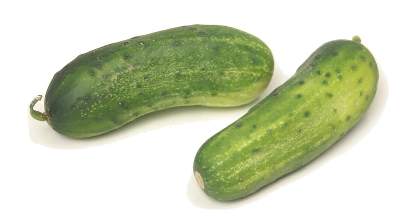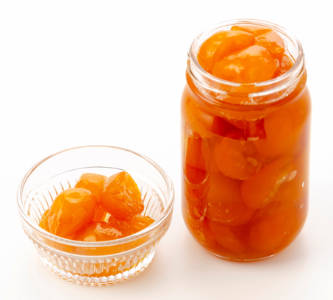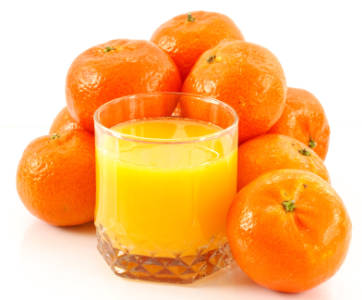Fruit Category

Includes berries, citrus fruit, melons, tropical fruit, and tomatoes
Fruits are the matured ovaries of plants, containing the seeds for the next generation of plants. Many plants cunningly make their fruits sweet, the better to attract animals like us to eat them and disperse the seeds. Fruits are often delicious enough to eat out of hand, but they can also be made into tarts, compotes, shakes, juices, preserves, liqueurs, and many other things.
kimia dates
These dark kimia dates are grown widely in southern Iran. They are moist and soft.
Learn moreKirby cucumber
This short, versatile cucumber is used for both slicing and pickling. It's small, with bumpy yellow or green skin. Like the English cucumber, it has a thin skin and inconspicuous seeds.
Learn morekiwano
This melon has a gorgeous orange rind with spikes--poke a stick in it and you'd have a medieval mace for a Halloween costume. The yellow-green flesh has the consistency of jello, and tastes a bit like cucumbers.
Learn morekiwi fruit
This small, oblong fruit is has fuzzy brown skin and beautiful green flesh dotted with edible black seeds. It tastes like a cross between gooseberries and strawberries. It's very versatile--you can eat it as a snack, blend it into sauces or sorbets, or peel and slice it as a garnish. It also contains an enzyme that tenderizes meat. Select kiwis that are hard, and allow them to ripen at room temperature for a few days.
Learn morekokum
This Indian souring agent is made from dried mangosteen peels. It's often used in fish dishes. Look for it in Indian markets.
Learn morekumquat
These look like grape-sized oranges, and they can be eaten whole. The flavor is a bit sour and very intense. They peak in the winter months.
Learn morelamuyo pepper
This hard-to-find sweet pepper is smaller and sweeter than its cousin, the bell pepper, with which it's interchangeable.
Learn morelangsat
This sweet and sour fruit from Southeast Asia looks like a small potato. Don't eat the bitter seed inside.
Learn morelemon
This very sour citrus fruit is rarely eaten out of hand, but it's widely used for its juice, rind, and zest. Varieties include the Eureka lemon, which is what you're most likely to find in markets, the Lisbon lemon, which shows up in the winter and is smaller and smoother than the Eureka, and the trendy Meyer lemon, which is much sweeter and pricier than an ordinary lemon. When buying lemons, select specimens that are smaller, thin-skinned, and heavy for their size.
Learn morelemon cucumber
This versatile cucumber is sweet and flavorful, and doesn't have much of the chemical that makes other cucumbers bitter and hard to digest. Though it's often served raw, it's also a good pickling cucumber.
Learn morelemon marmalade
This is made by boiling the fruit and peel of lemons with sugar, pectin, and water. It manages to be bitter, sour, and sweet all at once, which many people find delightful.
Learn morelighter Bake
This is a mixture of pureed prunes and apples that serves as a fat substitute in baking.
Learn morelime
These tart green fruits are similar to lemons, but they're more acidic and have their own unique flavor. Varieties include the common Persian lime = Tahiti lime and the smaller, less juicy, and more acidic Florida key lime = key lime = Mexican lime. When buying limes, select specimens that are dark green, smaller, thin-skinned, and heavy for their size.
Learn morelimequat
This is a cross between a lime and a kumquat. It's similar in size and shape to a kumquat, but with a green or yellow-green skin. It has a strong lime flavor.
Learn morelingonberry
These tart relatives of the cranberry grow only in cold climates. They're often made into jams, juices, sauces, syrups, or compotes. Scandinavians like to serve sweetened lingonberries with game.
Learn morelitchi
his popular Chinese fruit is about the size of a walnut, with a bumpy red shell encasing white translucent pulp that's similar in texture to a grape. The flavor is sweet, exotic, and very juicy. Don't eat the shell or the seed. Fresh litchis are available from May to July. If you can't find them, canned litchis are a good substitute. Don't confuse fresh litchis with litchi nuts, which are sun-dried litchis that have a much different texture.
Learn morelitchi nut
These are sun-dried litchis. The outer shells are brown and the meat inside looks like a large raisin. Look for them in Asian markets.
Learn moreloganberry
These are like blackberries, only they're dark red when ripe and more acidic. They're especially good in pies and preserves.
Learn morelongan
Longans are very similar to lychees and rambutans. You can buy them fresh (in the summer), dried or canned.
Learn moreloquat
These are popular in Asia, where they're eaten raw and cooked into sauces that accompany meat. They bruise very easily, which may explain their rarity in American markets
Learn moremamey sapote
These are about the size of a large sweet potato. The flesh is salmon-colored, with a sweet, berry-like flavor. They're great for eating out of hand, or for making fruit salads or smoothies. Markets often sell them while they're still hard and underripe, so you need to set them on the counter for a few days until they yield when gently squeezed. Peel them and remove the seeds before serving.
Learn moremandarin orange
These have a pleasant enough flavor, but their big asset is that they come out of their peels and segment easily, so you can eat them in your good clothes. Varieties include the popular tangerine, the seedy but juicy honey tangerine = Murcott, the satsuma orange, the sweet and tiny clementine orange, and the seedy and orange-flavored temple orange.
Learn moremango
It's always a challenge to eat a mango. The pulp clings desperately to both peel and seed, and it can turn into a mushy mess by the time you free it. Despite this, the mango is one of the most popular fruits in the world. It's sweet and juicy, and it has a wonderful, distinctive flavor. Select richly colored, firm mangoes, then let them ripen at home for a few days. Frozen mangoes are good substitutes for fresh.
Learn moremangosteen
Some claim that this is the most delicious fruit on the planet, though it's hard to find in the United States. It's about the size of a tomato, and has a leathery, mottled skin.
Learn more




































































































































































































































































































































































